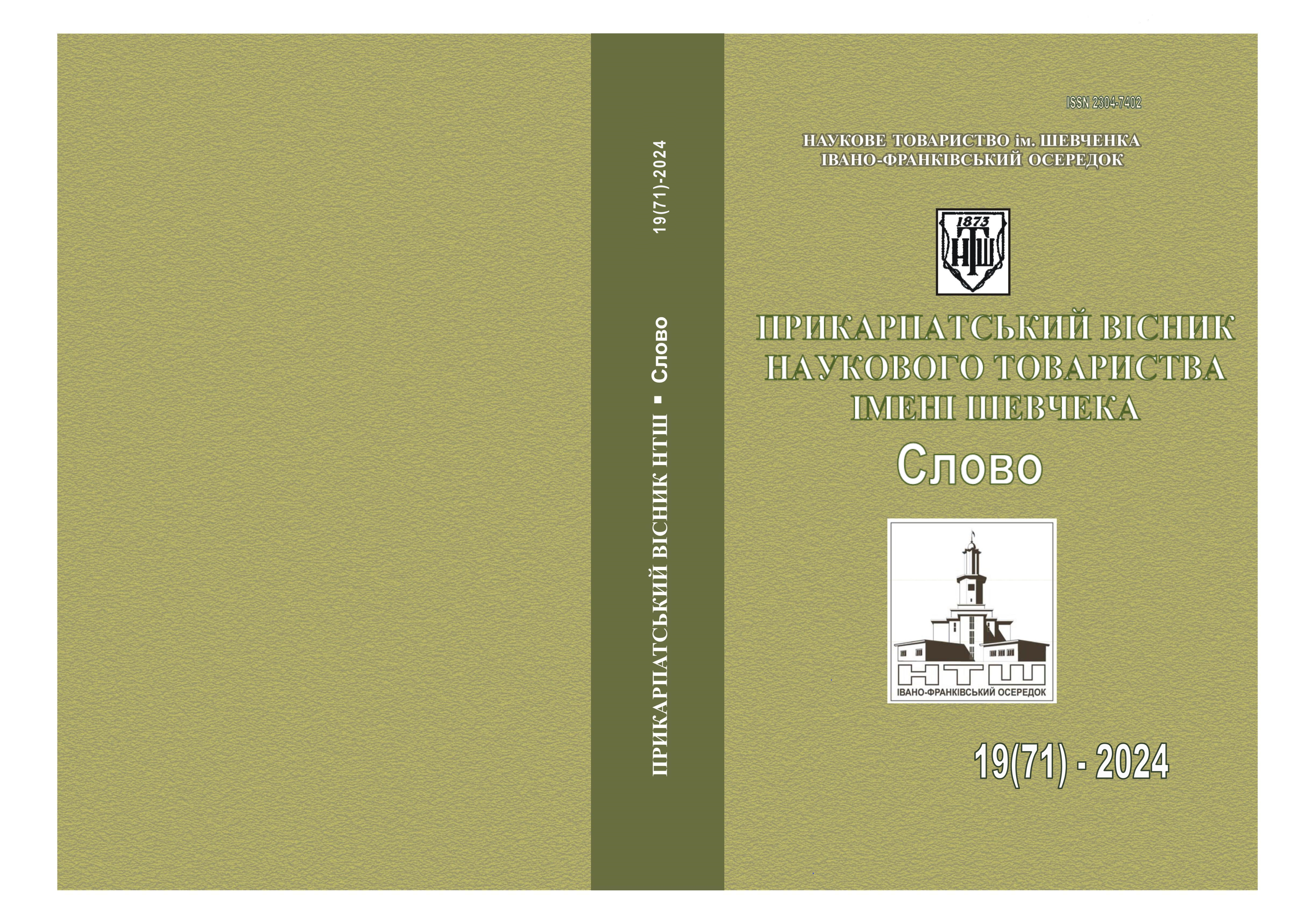REMOVABLE NOUNS OF «COMMON GENDER»: PROBLEMATIC ASPECTS
DOI:
https://doi.org/10.31471/2304-7402-2024-19(71)-246-260Keywords:
grammatical category of gender, nouns of "paired gender", nouns of "common gender", grammatical meaning, femininities, masculinities.Abstract
The purpose of the study is to identify and analyze the factors and means of expressing the grammatical meaning of gender in inflected nouns - grammatical homonyms, which, depending on the context, can nominate persons or creatures of both sexes..
Research methodology. In order to systematize the material, to reveal the factors and methods of differentiation of grammatical gender meanings in the nouns of the "common gender", the descriptive (with the techniques of component and contextual analysis) was used. The comparative and typological analysis was also used to clarify the lexical-semantic, morphological, word-formation, and syntactic means that influence the gender of a certain grammatical form of a noun.
The results of the study. It has been established that the mutable nouns of the "common gender" are the names of persons (rarely animals), representing the semantic and grammatical manifestation of the category of gender. They do not form a separate gramma of the genus but are grammatical homonymous forms that, depending on the context, can nominate persons of both sexes or distinguish males or females within faunonyms. The majority of mutable nouns of the "common gender" belong to feminines (homonymous forms marked with grammatical feminine gender), among which both stylistically neutral and expressively colored lexemes have been attested. Masculinities (homonymous forms marked with grammatical masculine gender) constitute the periphery of the group of "common gender" nouns, since, given the current trends in the gender categorization of nouns, they lose the status of homonymous forms, forming correlative pairs with feminine derivatives, the components of which differ only in the grammatical meaning of gender. In modern linguo-Ukrainian studies, they are defined as "paired gender" nouns.
Practical significance. The article analyzes in detail those noun forms that have different interpretations in different lexicographic sources. The author points to the adjacent groups of nouns that represent the phenomenon of semantic and grammatical asymmetry of genitive forms that do not belong to the "paired" nouns. The change in the status of masculinities in the modern Ukrainian language is substantiated.
References
Алексієнко Л. А., Зубань О. М., Козленко І. В. Сучасна українська мова: Морфологія: підручник / за ред. А.К. Мойсієнка. Київ, 2013. 524 с.
Безпояско О. К. Іменні граматичні категорії. Київ : Наук. думка, 1991. 171 с.
Безпояско О. К., Городенська О. К., Русанівський В. М. Граматика української мови. Морфологія. Київ : Либідь, 1993. 336 с.
Брус М. П. Фемінітиви в українській мові: генеза, еволюція, функціонування. Івано-Франківськ: Прикарпатський національний університет імені Василя Стефаника, 2019. 440 с.
Валюх З. Іменники «межових» моделей творення: націотвірний і словотвірний аспекти. Рідне слово в етнокультурному вимірі. 2013. С. 45–53.
Великий тлумачний словник сучасної української мови : 250000 / уклад. та голов. ред. В. Т. Бусел. Київ; Ірпінь: Перун, 2005. 1728 с.
Вихованець І. Р., Городенська К. Г. Теоретична морфологія української мови : академічна граматика української мови. Київ : Пульсари, 2004. 400 с.
Горпинич В. О. Морфологія української мови : підручник для студентів вищих навчальних закладів. Київ : ВЦ «Академія», 2004. 336 с.
Загнітко А. П. Теоретична граматика сучасної української мови. Морфологія. Синтаксис. Донецьк: ТОВ «ВКФ «БАО», 2011. 992 с.
Лаврінець О., Симонова К., Ярошевич І. Сучасна українська мова. Морфеміка. Словотвір. Морфологія. Київ : Видавничий дім «Києво-Могилянська академія», 2019. 524 с.
Мерінов В. В. Функціонально-категорійна аспектуальність граматичного роду іменника в українській мові. Харків : Вид-во ХНПУ ім. Г. С. Сковороди, 2005. 211 с.
Мороз Т. Ю. Семантико-граматична асиметрія морфологічних категорій іменника : автореф. дис. … канд. філол. наук : 10.01.02. Харків, 2008. 18 с.
Мороз Т. Характер співвідношення семантики та граматики на рівні морфологічної категорії роду іменника. Наукові записки. Серія: філологічні науки (мовознавство) / Кіровоград. держ. пед. ун-т ім. В. Винниченка. Кіровоград, 2014. Вип. 127. С. 432–436.
Понкратова В. М. Граматична категорія роду іменника в українському мовознавстві XX століття. Наукові праці [Чорноморського державного університету ім. Петра Могили комплексу «Києво-Могилянська академія»]. Сер. : Філологія. Мовознавство. 2014. Т. 221, Вип. 209. С. 74−78.
Халіман О. В. Оцінні значення іменників спільного роду як проблема лексикографування (на матеріалі аналізу відповідей респондентів). Вісник Дніпропетровського університету. Серія : Мовознавство. 2011. Т. 19, вип. 17(2). С. 172–179.
Шевельов Ю. Вибрані праці. Кн. 1 : Мовознавство. Київ: Вид. дім «Києво-Могилянська академія», 2008. 583 с.
Горох – українські словники. URL: https://goroh.pp.ua/Словозміна/
Словник UA. Портал української мови та культури. URL: https://slovnyk.ua/index.php
Словник сучасної української мови (1970–1980). URL: https://sum.in.ua/
Словник української мови online. Томи 1-14 (а-префере́нція) URL: https://sum20ua.com/Entry/index?wordid=1&page=0
Словопедія. Словник іншомовних слів. URL: http://slovopedia.org.ua/36/53402/240857.html

